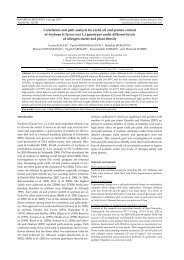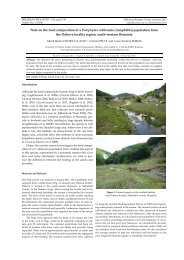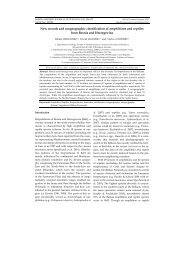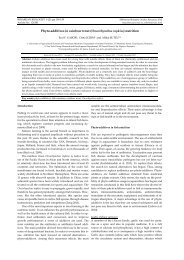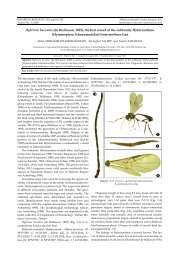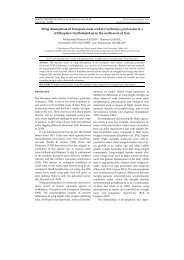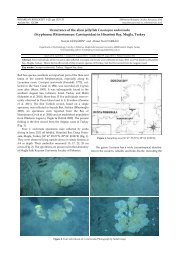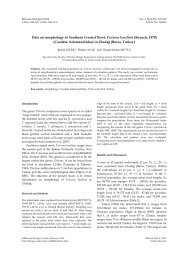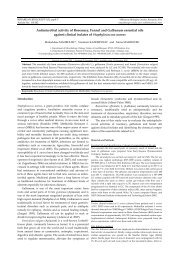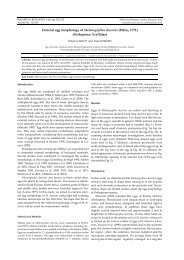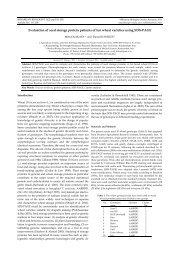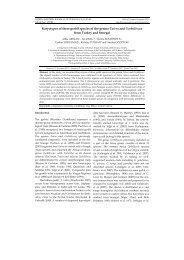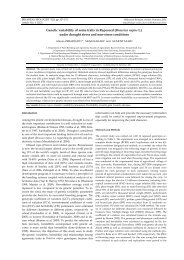Contribution to the knowledge of the Reptile fauna and diversity in ...
Contribution to the knowledge of the Reptile fauna and diversity in ...
Contribution to the knowledge of the Reptile fauna and diversity in ...
You also want an ePaper? Increase the reach of your titles
YUMPU automatically turns print PDFs into web optimized ePapers that Google loves.
Citation as onl<strong>in</strong>e-first paper: North-western Journal <strong>of</strong> Zoology 10: art.131519<br />
B. Sterijovski et al.<br />
ogeographic classification <strong>of</strong> <strong>the</strong> reptile species <strong>in</strong><br />
FYROM, d) analyze <strong>the</strong> similarity <strong>of</strong> Macedonian<br />
reptile <strong>fauna</strong> with <strong>the</strong> neighbor<strong>in</strong>g countries <strong>of</strong> <strong>the</strong><br />
Balkan Pen<strong>in</strong>sula.<br />
Materials <strong>and</strong> methods<br />
Two types <strong>of</strong> records became part <strong>of</strong> <strong>the</strong> study: (i) records<br />
previously published <strong>in</strong> <strong>the</strong> literature <strong>and</strong> (ii) unpublished<br />
(new) records. They are as such, dist<strong>in</strong>guished <strong>in</strong><br />
<strong>the</strong> grid maps. Faunistic records (both literature <strong>and</strong> new<br />
ones) were mapped <strong>in</strong> <strong>the</strong> 10 km x 10 km UTM (universal<br />
Transverse Merca<strong>to</strong>r) geographic coord<strong>in</strong>ate grid system.<br />
Dur<strong>in</strong>g fourteen consecutive years (from 1999 <strong>to</strong><br />
2012) numerous field trips were conducted <strong>in</strong> different<br />
regions <strong>of</strong> FYROM. Most field trips were done <strong>in</strong> July <strong>and</strong><br />
August, <strong>and</strong> some were carried out from April <strong>to</strong> September.<br />
Most specimens were collected, exam<strong>in</strong>ed for<br />
identification, pho<strong>to</strong>graphed <strong>and</strong> released <strong>in</strong> orig<strong>in</strong>al<br />
habitats. For identification, field guides <strong>of</strong> Radovanović<br />
(1951), Arnold & Ovenden (2002) were used, <strong>and</strong> taxonomy<br />
<strong>and</strong> nomenclature was adopted from Speybroeck et<br />
al. (2010). Some samples (e. g. road kills) were collected<br />
for more detailed studies <strong>and</strong> were deposited at <strong>the</strong> Herpe<strong>to</strong>logical<br />
collection <strong>of</strong> Macedonian Ecological Society or<br />
<strong>the</strong> private collection <strong>of</strong> Bogoljub Sterijovski <strong>in</strong> Skopje.<br />
The majority <strong>of</strong> literature data are given with exact<br />
localities. However, <strong>in</strong> several old references given by<br />
Dimovski (1960, 1963, 1966b) <strong>and</strong> Karaman (1922, 1931),<br />
only general distribution <strong>of</strong> certa<strong>in</strong> species is given (e.g.<br />
mounta<strong>in</strong>s or regions) without precise localities. Due <strong>to</strong><br />
imprecision <strong>of</strong> those data, we did not <strong>in</strong>clude <strong>the</strong>m <strong>in</strong> <strong>the</strong><br />
distribution maps <strong>and</strong> fur<strong>the</strong>r analyses.<br />
For analyses <strong>of</strong> reptile’s <strong>diversity</strong> <strong>and</strong> <strong>the</strong> designation<br />
<strong>of</strong> centres <strong>of</strong> herpe<strong>to</strong>logical <strong>diversity</strong> <strong>in</strong> FYROM, we used<br />
an application created <strong>in</strong> Visual Basic 6.1 <strong>in</strong> <strong>the</strong> program<br />
W<strong>in</strong>Word 2003 (Niketić, 1999), us<strong>in</strong>g <strong>the</strong> method by Walter<br />
& Straka (1970), at National Grid UTM Reference for<br />
FYROM 10 x 10 km.<br />
Similarities with all Balkan’s countries were calculated<br />
accord<strong>in</strong>g <strong>to</strong> <strong>the</strong> Sorensen Similarity Index. Data on<br />
<strong>the</strong> presence <strong>of</strong> <strong>the</strong> taxa follow Gasc et al. (1997); for Bosnia<br />
& Herzegov<strong>in</strong>a, Greece (exclud<strong>in</strong>g Crete <strong>and</strong> Eastern<br />
Aegean Isl<strong>and</strong>s) <strong>and</strong> Bulgaria with respect <strong>to</strong> recent publications<br />
(Jablonski et al. 2012, Valakos et al. 2008, S<strong>to</strong>janov<br />
et al. 2011).<br />
For zoogeographic analyses, chorotypes were identified<br />
accord<strong>in</strong>g <strong>to</strong> <strong>the</strong> classification <strong>of</strong> Vigna Taglianti et al.<br />
(1999). Chorotype structure <strong>of</strong> <strong>the</strong> reptile <strong>fauna</strong> <strong>of</strong> FY-<br />
ROM was compared with that <strong>of</strong> two neighbour<strong>in</strong>g countries<br />
<strong>of</strong> <strong>the</strong> central part <strong>of</strong> <strong>the</strong> Balkan Pen<strong>in</strong>sula: Serbia<br />
<strong>and</strong> Montenegro.<br />
Results<br />
UNCORRECTED PROOF<br />
Accord<strong>in</strong>g <strong>to</strong> relevant herpe<strong>to</strong>logical literature<br />
(D<strong>of</strong>le<strong>in</strong> 1921, Buresch & Zonkow 1932, 1934,<br />
Karaman 1928, 1931, 1937, 1938-39, 1939, Radovanović<br />
1951, Dimovski 1959a,b, 1963, 1964,<br />
1966a,b, 1971, 1981, Džukić & Grubač 1988,<br />
Petrušev et al. 1990, Petkovski et al. 2000/2001,<br />
Džukić et al. 2001, Sterijovski 2005), 32 reptile species<br />
are present <strong>in</strong> FYROM. Field research conducted<br />
dur<strong>in</strong>g fourteen years, confirmed <strong>the</strong> presence<br />
<strong>of</strong> all 32 species <strong>in</strong> this terri<strong>to</strong>ry. Approximately<br />
65% <strong>of</strong> <strong>the</strong> terri<strong>to</strong>ry was covered (393 localities<br />
– 188 <strong>of</strong> 294 <strong>to</strong>tals UTM 10 x 10 squares).<br />
Unfortunately, <strong>in</strong>tensive searches were not completed<br />
<strong>in</strong> <strong>the</strong> all parts <strong>of</strong> FYROM equally, thus<br />
some parts are not covered well enough with <strong>the</strong><br />
data.<br />
For every reptile species distribution <strong>in</strong> FY-<br />
ROM, field data (with region, locality, altitude <strong>and</strong><br />
date <strong>of</strong> f<strong>in</strong>d<strong>in</strong>g) are given <strong>in</strong> Appendix I, <strong>and</strong> literature<br />
data (with localities <strong>and</strong> references) are<br />
presented <strong>in</strong> Appendix II. Records <strong>of</strong> all species <strong>in</strong><br />
FYROM are given <strong>in</strong> Figure 1(A-C) (National Grid<br />
UTM 10 x 10 km Reference).<br />
Results <strong>of</strong> this study <strong>and</strong> published records<br />
show that <strong>the</strong> most common representatives (recorded<br />
<strong>in</strong> more than 20% <strong>of</strong> <strong>the</strong> country – 60 or<br />
more <strong>of</strong> <strong>to</strong>tal 294 UTM squares) <strong>of</strong> Macedonian<br />
herpe<strong>to</strong><strong>fauna</strong> are: T. hermanni, A. fragilis, L. viridis,<br />
L. tril<strong>in</strong>eata, P. erhardii, P. muralis, N. natrix, C. austriaca,<br />
D. caspius, Z. longissimus <strong>and</strong> V. ammodytes<br />
(Table 1).<br />
Species that were moderately distributed (recorded<br />
<strong>in</strong> 5 – 20% <strong>of</strong> <strong>the</strong> terri<strong>to</strong>ry – 15-60 <strong>of</strong> <strong>to</strong>tal<br />
294 UTM squares) <strong>in</strong> our results <strong>and</strong>/or <strong>in</strong> literature,<br />
data are: T. graeca, A. kitaibellii, L. agilis, P.<br />
tauricus, T. vermicularis, N. tessellata, P. najadum, E.<br />
quatuorl<strong>in</strong>eata, M. monspessulanus <strong>and</strong> V. berus (Table<br />
1).<br />
Accord<strong>in</strong>g <strong>to</strong> current data, extremely rare reptilian<br />
species (recorded <strong>in</strong> less <strong>the</strong>n 5% <strong>of</strong> <strong>the</strong><br />
country – up <strong>to</strong> 15 <strong>of</strong> <strong>to</strong>tal 294 UTM squares) <strong>in</strong><br />
FYROM are: E. orbicularis, M. rivulata, C. kotschyi,<br />
P. apodus, A. nigropunctatus, Z. vivipara, E. jaculus,<br />
H. gemonensis, T. fallax, Z. situla <strong>and</strong> V. urs<strong>in</strong>ii (Table<br />
1).<br />
Analyses <strong>of</strong> <strong>the</strong> reptile <strong>diversity</strong> <strong>of</strong> <strong>the</strong> FY-<br />
ROM showed that <strong>the</strong> regions with <strong>the</strong> highest<br />
species <strong>diversity</strong> are: <strong>the</strong> Prespa <strong>and</strong> Ohrid Lake<br />
Region (DL 83, DL 93), Skopje region (EM 25), Veles<br />
region (EM 61, EM 70) <strong>and</strong> <strong>the</strong> Dojran Lake<br />
Region (FL 46), with 18-21 reptile species per UTM<br />
10 x 10 squares (Figure 2).<br />
Sorensen’s similarity <strong>in</strong>dex was used for comparative<br />
analysis <strong>of</strong> reptile <strong>fauna</strong>s from all <strong>the</strong> Balkan<br />
countries. Results showed that Macedonian



